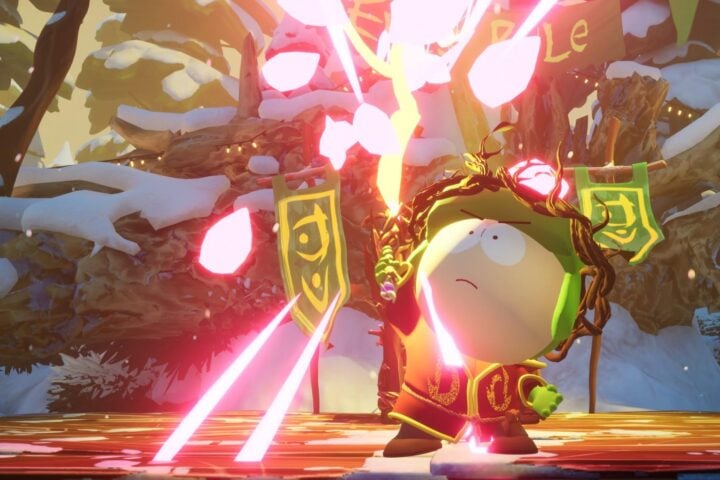It’s rare to find a game as overwhelming in its technical mastery as Japanese developer Vanillaware’s Unicorn Overlord. Not technical in the sense of production value (though the game is no slouch in that regard), but in its mechanical design. It’s a tactical RPG whose real-time battles you play from a top-down perspective and can be freely paused so you can issue commands. Those battles play out as brief side-on cutscenes with two units (squads consisting of one-to-six individual characters) launching attacks at each other in sequence, and they’re separated by overworld exploration and a smattering of dialogue-heavy story beats.
The closest precedent for the battle stages of Unicorn Overlord is Quest Corporation’s Ogre Battle series (the sister series/progenitor of Tactics Ogre), which, beginning in 1993, combined real-time strategy and then nascent tactical RPG elements in much the same way. One major distinction is that, while in Ogre Battle you could input commands during battles—giving yourself some degree of control in real time—Unicorn Overlord makes the stricter decision to take all player control away once a pair of units are committed to a fight. As such, Unicorn Overlord’s tactical friction occurs more heavily in the planning stage.
This ability to plan ahead—with a degree of control that’s almost overwhelming—is the cornerstone of the game’s mechanical achievement. Specifically, characters’ combat abilities can be programmed to target certain unit types or formation positions, or to trigger in response to a wide array of different criteria. For example, a healer who has the Quick Heal ability, which is used as a reaction after an allied character takes damage, could instead be ordered to only use Quick Heal after a character drops below 50% HP, thus making the healing more efficient. Furthermore, the same healer could be instructed not to use Quick Heal on tougher frontline characters in order to reserve it for keeping more vulnerable back line characters alive.
This kind of granular control over entire squads of characters, each with a half dozen or so skills at their disposal, means that battles play out more like a duel between Rube Goldberg machines—to either satisfying or frustrating effect. But that is countered by a necessary injection of tactical uncertainty. Although the battle stages offer battle previews showing exactly how much HP each unit will lose by the end, this information is much less reliable than it seems at first. Since units must move in real time after being issued commands, it’s common for a situation to change dramatically by the time they actually arrive at a battle. Enemy units may heal, or they might move into position such that they can support each other with ranged attacks.
It’s also unclear from looking at these previews which specific characters will actually receive said damage. A total HP loss of one, for instance, may mean that a character is healed for 39 HP, while another is hit for 40—enough to knock it out of the fight. Importantly, these tactical gray areas feel less contrived than the random chance of a critical hit or a missed attack that fuzzes up other tactics games. Instead, they feel not exactly predictable, but manageable and fair.
Unicorn Overlord’s graphical style, like that of most other Vanillaware titles, is top notch. The overworld evokes the ’90s stylings of its inspirations but is richer and more detailed than RPG overworlds of the time. Its muted, earthy color palette and squat, rounded shapes have a pleasant, almost clay-like quality. When the game switches to its side-on perspective for combat cutscenes and many story beats, characters appear against striking static backdrops.
Those backdrops are often surprising in their lush vibrance. They’re also remarkably varied, often changing to reflect differences in region or weather condition, with woodland settings, for example, looking vastly different on a sunny day in the craggy, mountainous Drakenhold when compared to a stormy night in the magic-tinged elven homeland Elheim.
The sole letdown in the visual department is the fact that about half of the game’s women are depicted in a cartoonishly sexualized way that’s never really extended to the men. It may seem like a small complaint, but it’s strange and slightly embarrassing seeing such a nuanced and thoughtful game (that is, presumably, targeted mostly at adult fans of the genre) decorated with women who are proportioned like graffiti on the walls of a middle school boys’ bathroom.
The story might initially come off as a letdown too, with its pedestrian fantasy setting and mostly ordinary character arcs. But sometimes stories in games simply serve to set the mood, as a kind of backdrop against which you experience the main event—the play itself. Few complain, for instance, that Mario games aren’t surprising enough in their narratives. In much the same way, Unicorn Overlord’s predictable plot beats hang out in the background, unoppressive, so that you’re free to let the rush of its expertly crafted systems wash over you unimpeded.
This game was reviewed with code provided by fortyseven communications on March 8.
Since 2001, we've brought you uncompromising, candid takes on the world of film, music, television, video games, theater, and more. Independently owned and operated publications like Slant have been hit hard in recent years, but we’re committed to keeping our content free and accessible—meaning no paywalls or fees.
If you like what we do, please consider subscribing to our Patreon or making a donation.


